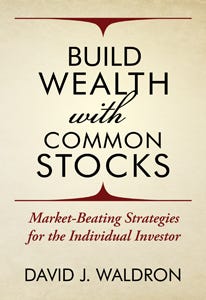How to Build a High-Quality Stock Portfolio at Value Prices
Using the QVI Stock Picks research checklist to construct and manage a portfolio or check company quality and share price value on a watchlist
Welcome to Quality Value Investing (QVI), where the QVI Stock Picks have collectively achieved alpha since 2008. To preview the newsletter posts and research reports, become a free subscriber. Upgrade to a paid subscription to access full text and audio of the newsletter and the QVI Stock Picks Real-Time Performance Tracker.
Audio voiceover:
Substack’s AI-generated voiceover is now available on Quality Value Investing. To access it, open the post in the Substack app. Please share your thoughts on the audio in the comments or through direct message. I will use AI to clone my voice for future QVI posts.
Learn more about audio voiceovers:
https://davidjwaldron.substack.com/p/audio
As a former executive in postsecondary education, I can confirm that mastering a subject or skill requires thousands of hours of repetitive study and practical experience.
This narrative QVI post combines the core principles and strategies of quality-driven value investing by using its proprietary checklist to identify high-performing companies whose common shares are trading at reasonable prices, enabling further research for potential inclusion in long-term, self-managed portfolios with alpha-generating potential.
QVI has generated alpha since 2008 by focusing on a company’s current wealth and the present value of its stock price, rather than depending on unreliable predictive analysis and overly complex business modeling.
Founding and Premium subscribers can utilize QVI’s proprietary research checklist and access the paywalled QVI Stock Picks to help build a self-managed portfolio or evaluate the quality and value of companies and stock holdings already in their portfolio or on a watchlist.
Using the QVI Stock Picks Checklist as a Proxy
QVI’s 41 stock picks have collectively generated alpha since 2008 by primarily focusing on a company’s current wealth and the present value of its stock price.
I rate each stock holding in the QVI Real-Time Stock Picks Performance Tracker based on my current view of buy, hold, or sell.
Buy means bullish or add.
Hold means neutral or watch.
Sell means bearish or avoid.
Please note that my opinion influences the ratings given to the QVI Stock Picks. Subscribers should perform their due diligence or consult a professional before making any investment decisions.
Although I favor the long-term growth potential of every company included in the active QVI Stock Picks, I buy or add to stocks rated bullish based on valuation multiples or those I considered undervalued at the time of analysis. Since each stock was rated a buy when added, subscribers should watch for new additions, as I rarely add to a position unless the initial outlook is bullish.
As stock picks mature, hold ratings become common. However, each holding could either be upgraded back to a buy due to unforeseen market conditions or downgraded to a sell after a decline in company fundamentals.
In summary, I assign equal weights to the QVI Stock Picks holdings to track benchmark performance. I also allocate equal weights to the investments in our concentrated family portfolio, as shown by the QVI Current Stock Picks | Good Ideas Owned by David. I occasionally add more high-quality companies with promising long-term prospects that are trading at fair prices and are rated a buy in the portfolio updates. I usually publish the updated current views quarterly.
QVI’s Stock Picks Research Checklist Framework
Performing DIY or retail-level common stock investment research is best done within a structured model or outline that leads to an unbiased conclusion — whether bullish, neutral, or bearish — about the targeted company and its stock.
The primary purpose of the research checklist is to develop an opinion thesis by analyzing publicly traded companies and their stocks. As shown throughout the Quality Value Investing Archives, the research methods include:
The value proposition an enterprise offers to its customers, including the products or services provided and the competitive landscape as defined by its economic moat, as well as my value proposition elevator pitch.
The fundamentals, or management returns, include the competence of senior executives and board members.
The average of the sum of shareholder yields or the equity bond rate measures how the stock compares to the prevailing yield of the 10-Year Treasury benchmark.
The valuation multiples of common shares or their intrinsic value.
The potential downside risks of the enterprise and its stock price.
Checklist items can include analyzing the market consensus to assess overall sentiment and employee satisfaction. The most crucial aspect is the bottom-up analysis of the company and its common stock to identify solid reasons why the business deserves a share of ownership or not.
Research the company and craft a compelling story for your investment thesis. Quality-focused investors conduct bottom-up analyses, aiming to identify exceptional companies regardless of the industry's, sector's, or broader macroeconomic factors' performance, which are inherently unpredictable.
Target Major Exchange-Traded Stocks
Target the major US exchange-traded common shares — NYSE and NASDAQ — of high-quality, predominantly dividend-paying companies or the equivalent exchange in the domiciled country.
Avoid over-the-counter (OTC) issues and microcaps as speculative investments. Concentrate on large, mid, and small-cap stocks, and leave the more speculative micro-caps to professionals and market speculators. The large, mid, and small-cap common shares traded on major exchanges offer a potentially wider margin of safety for long-term capital preservation, growth, and income.
We achieve true alpha when our small caps turn into mid caps and our mid caps grow into large caps. Large caps sometimes become mega caps. However, each can revert to mid-caps, small-caps, micro-caps, or even worse, lose their caps.
Market capitalization reflects sentiment. Despite what others may think, an attractive stock price of a quality company should not distract you as long as the stock continues to grow over time at a rate that meets or exceeds what you expected when you bought it. Focus more on the long-term competitive strengths of the company's products or services, and how effectively management allocates capital, rather than on transient investor opinions or nearsighted market reactions.
Profiles, Objectives, and Strategies
To support the mission of finding quality at value with wide margins of safety and building wealth through the power of compounding across each market cycle, the QVI Stock Picks offer members an actionable model that reflects our family’s concentrated portfolio, along with expanded and diversified recommendations.
The QVI Stock Picks holdings provide do-it-yourself, long-term, quality-focused value investors with exceptional ideas worth further investigation. I support QVI’s stock picks with corresponding user guides, a daily real-time performance tracker, and checklist-based research reports on each company’s current wealth and its stock price’s current value. The performance tracker and supporting research are exclusive to Founding (lifetime) and Premium (annual or monthly) subscribers of Quality Value Investing.
This section outlines the profile, objectives, and strategies of the QVI Stock Picks, providing a framework for targeting holdings that best align with an investor’s goals.
Portfolio Profile
The QVI Stock Picks generally serve as a non-marketable, illustrative list of publicly traded common shares of quality large, mid, and small-cap companies held in our concentrated family portfolio or offered as diversified recommendations for subscribers to perform further due diligence.
Each holding has the potential for superior total return through compounding — capital gains plus dividend income — safeguarded by acceptable margins of safety, with the ability to generate alpha across market cycles.
The QVI Stock Picks highlight the difficulty of finding new ideas that are as valuable as current holdings. As always, it's a double-edged sword — an overly diversified stock portfolio can benefit from trimming holdings or using passive index hedging to reduce risk and cut costs.
Nonetheless, focused portfolios of top-performing, high-quality compounders bought at reasonable prices provide the best chance of achieving alpha in long-term, do-it-yourself common stock investing.
Portfolio Objectives
The QVI Stock Picks aim for long-term growth of both principal and income. Generating a satisfactory current income through regular dividends is essential to achieving the total return goal. As a result, most companies in the baskets pay regular dividends.
The QVI portfolio statement offers a clear example of an objective statement.
Buy and hold the common shares of US exchange-traded, predominantly dividend-paying, well-managed, financially sound businesses that produce easy-to-understand products or services, have enduring competitive advantages from economic moats, enjoy steady free cash flow, and are trading at a discount to the perceived intrinsic value at the time of purchase. Then, of utmost importance and perhaps the biggest challenge, practice patience in waiting for the investment thesis to play out as projected over a long-term horizon.
Portfolio Strategies
The QVI Stock Picks Real-Time Performance Tracker shows focused and diverse groups of liquid, publicly traded common shares of large, mid-cap, and small-cap companies listed on major US exchanges.
In selecting components, the focus is on stocks of high-quality companies that appear undervalued by the market, considering a favorable long-term outlook for total return compounding and protected by acceptable levels of risk. I select constituents for the QVI Stock Picks based on a research and analysis checklist that considers current wealth and present value, encompassing both qualitative and quantitative company and stock measures.
The QVI selection process generally favors aspects and metrics related to the value proposition, management returns, enterprise downside risks, shareholder yields, valuation multiples, and share price downside risks.
Due diligence focuses on the asymmetric risks and rewards associated with the products or services, including returns on equity and invested capital, revenue growth, earnings per share growth, profit margins, free cash flow, the company’s debt coverage, and the stock price. I approach portfolio construction based on Warren Buffett’s philosophy, influenced by Benjamin Graham.
Ben Graham taught me that ‘Price is what you pay, value is what you get.’ Whether we’re talking about socks or stocks, I like buying quality merchandise when it is marked down.1 —Warren Buffett
I compare the performance of the QVI Stock Picks to the S&P 500 Index. When assessing the long-term results of each holding, the representative stocks in each basket are weighted equally against the benchmark to minimize biases.
Stock Screen User Guide and Definitions
Next, we will develop a stock screening checklist and a real-time performance tracker based on the principles, strategies, and practices outlined in Quality Value Investing’s newsletter posts and research reports.
The research screener checklist used to identify the QVI Stock Picks favors protocols that find companies with strong current financial health and stock prices with fair present value, each offering wide safety margins or below-average downside risks. Then, we benefit from price and dividend compounding, driven by high returns on capital investments.
The purpose of the checklist-driven screen is to identify companies worth further research for potential long-term ownership, rather than trading stocks on speculation in hopes of quick profits.
Holes in the Screen
Be cautious when using screens for researching stocks, and only use them to distinguish the valuable from the unworthy.
We should never rely solely on screeners for investment decisions because they often exclude good companies or include flawed ones. Be the stock picker who does proper due diligence.
Readers can find QVI’s preferred research checklist metric calculations on most online discount brokers or other free financial websites such as Google Finance and Yahoo Finance. I also find GuruFocus, Charles Schwab, and Morningstar useful for research on individual stocks. However, each site requires paid subscription upgrades or assets under management to access certain levels of information.
Making the Portfolio Cut
Any stock that passes the checklist screen becomes a candidate for further research and potential purchase or active coverage in the QVI Stock Picks Real-Time Performance Tracker.
As highlighted in the QVI newsletter’s related posts, managing portfolio allocation — reinvesting or deploying capital gains and dividends from each common stock holding — is just as important as asset allocation.
The margin of safety is a principle in value investing where an investor buys securities when the market price is significantly below the perceived intrinsic value. While sell-side analysts and buy-side portfolio managers on Wall Street use modeling formulas based on predictions of future free cash flows and other assumptions, rational, quality-focused investors on Main Street remain cautious of the assumptions behind those projections.
Base the margin of safety calculation on the valuation theory of identifying undervalued stocks of companies with strong earnings growth, high free cash flow margins, and superior returns on invested capital that exceed the business’s weighted average cost of capital.
Favor liquid, long- and short-term debt coverage, despite a perceived out-of-favor market sentiment indicated by attractive valuation ratios such as price-to-sales, price-to-earnings, price-to-operating cash flows, and enterprise value to operating earnings.
Search for past and future narrative posts and book chapters that feature Quality Value Investing’s Stock Picks Research Checklist, which assesses the key indicators listed above to determine the overall value proposition, earnings quality, management effectiveness, financial stability, equity bond rate, enterprise and share price downside risks, and valuation multiples of a targeted company and its common shares.
In the meantime, remember that the best way to achieve stock market alpha is by pursuing longer-term investments in the stakeholders and products or services of high-quality companies, rather than engaging in shorter-term momentum trading or trend-following of digitized, faceless stocks and other investment vehicles with limited utility.
Resources
QVI’s Research Reports Archive and Stock Picks Real-Time Performance Tracker offers the most recent analysis of the 41 QVI Stock Picks, including this post’s proprietary checklist.
The first chapter from the real-time final draft manuscript of my upcoming fifth book, Quality Value Investing: How to Pick the Winning Stocks of Enduring Enterprises, is now available on my author website, hosted on Substack.
About the Writer
David J. Waldron is the contributing editor of Quality Value Investing and the author of the international-selling book Build Wealth with Common Stocks: Market-Beating Strategies for the Individual Investor, as well as his upcoming fifth book, Quality Value Investing: How to Pick the Winning Stocks of Enduring Enterprises.
He is a private investor and a former expert advisor to hedge funds, mutual funds, private equity firms, and investment banks.
David’s mission is to inspire his readers to achieve their financial goals and dreams. His work has been featured in Substack Finance, Substack Business, Seeking Alpha, MSN Money, TalkMarkets, ValueWalk, Yahoo Finance, QAV—Australia’s #1 Value Investing Podcast, Money Life with Chuck Jaffe, LifeBlood with George Grombacher, The Acquirer’s Multiple, Capital Employed, and on platforms like Amazon, Barnes & Noble, Apple Books, The BookLife Prize, and Publisher’s Weekly.
David enjoyed a 25-year career as an executive in postsecondary education services. He earned a Bachelor of Science in Business Studies as a Garden State Scholar at Stockton University and completed The Practice of Management Program at Brown University. Learn more at davidjwaldron.substack.com.
“Investing advice is fairly commonplace, but here the author shares his own unique investment wisdom that readers will not find elsewhere.” —Critic’s Report, The BookLife Prize (Publishers Weekly)
Lifetime Founding subscribers can receive an author personalized jacketed case laminated hardcover edition of David’s fourth book.
Founding subscribers supporting QVI on Substack Finance also receive a complimentary permanent subscription renewal for the service’s lifetime. After the first paid year, no renewal is necessary. Please consider upgrading today.
If the button is not functional on your mobile device, enter this URL in your desktop or laptop browser and go to the Lifetime Founder column:
davidjwaldron.substack.com/subscribe
Earn Premium upgrade rewards when you refer members of your network, including family, friends, or colleagues, to the Quality Value Investing newsletter on Substack.
Disclosure: David J Waldron’s Quality Value Investing newsletter posts are for informational purposes only. Data accuracy is not guaranteed. Narratives and analytics are impersonal and not tailored to individual needs or portfolio construction beyond the QVI Stock Picks, presented solely for educational purposes. David is a private investor and author, not an investment adviser. Readers should conduct independent research or due diligence and consider consulting a fee-only financial planner, a licensed discount broker, a flat-fee registered adviser, a certified public accountant, or a specialized attorney before making investment, tax, or estate planning decisions.
Warren E. Buffett, Berkshire Hathaway, Inc., 2008 Letter to Shareholders, February 27, 2009, 5. Material is copyrighted and used with permission of the author.











